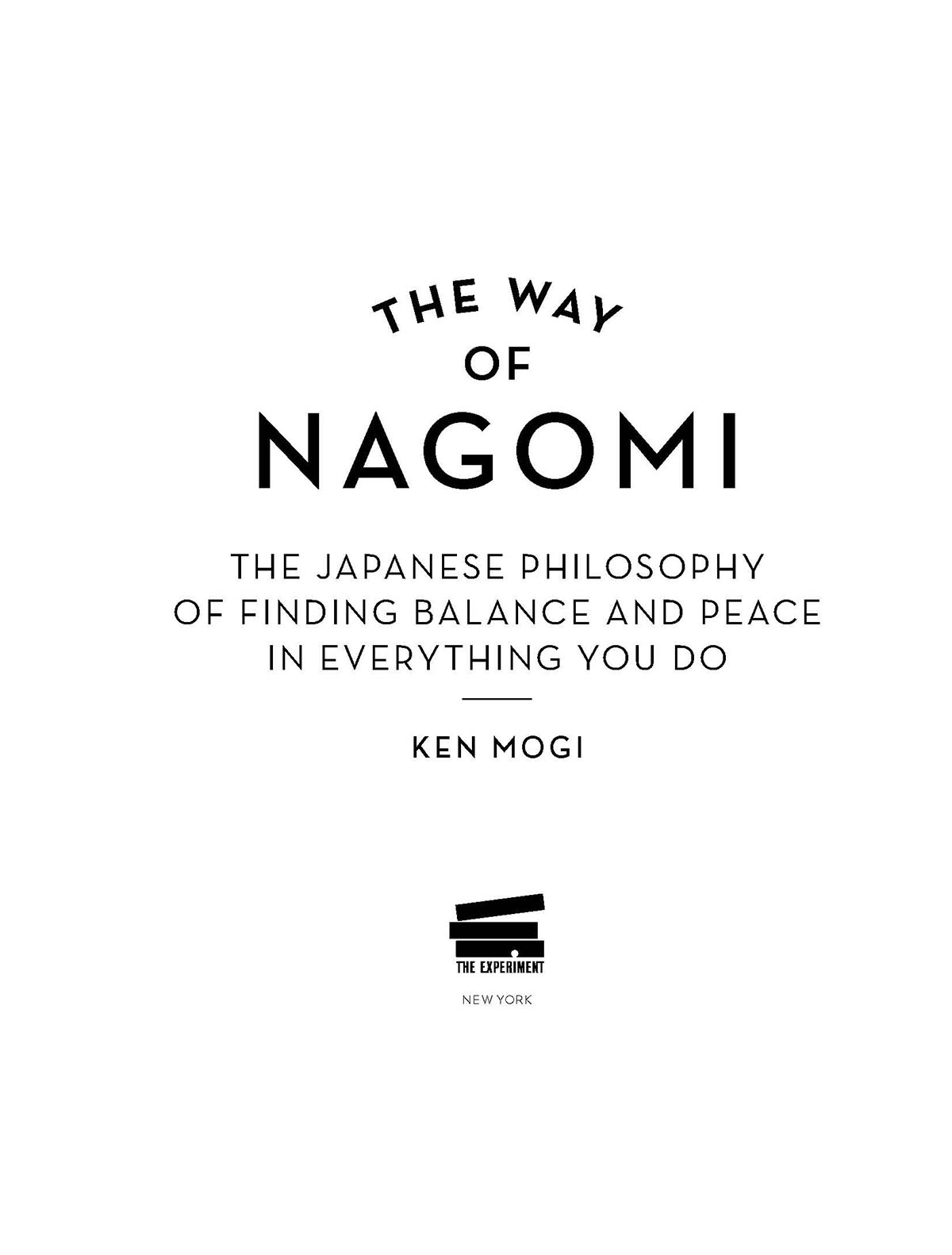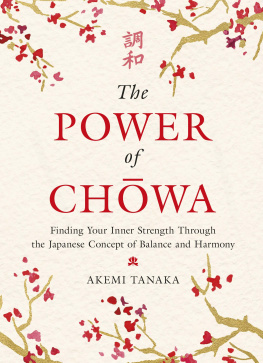Contents
Guide
Page List

Contents
Introduction
As you can see from the title, this is a book about nagomi. To explain this concept, I will refer to Japanese culture, history, and people in depth, but that is not to say it is an exclusively Japanese way of thinking. Japan has traditionally been open to influences from the outside world; because it is an island nation and of relatively small size, it has imported many external cultural influences with curiosity and zeal. Historically, Chinese influence has been crucial, and those of the Korean peninsula have also been pivotal in nurturing and enriching Japanese culture. Since the nineteenth century, Japan has eagerly absorbed Western culture, too.
The evolution of society is an interconnected and continuous process. In fact, the Japanese have always regarded society as constantly changing, ephemeral, and flexible. We even have a word for itukiyo (meaning floating world)that beautifully illustrates this philosophy. The floating world refers to the importance of the ephemeral in Japanese life, like the appreciation of cherry blossoms in the hanami festivities in spring, which last only for a few days in their prime. The concept of nagomi, which has developed in Japan in its own unique way, will have similar equivalents in other parts of the world and is certainly not exclusive to Japan in terms of its roots and implications. This very process of cultural assimilation demonstrates nagomi in action, as Japanese culture has sought harmony between indigenous and imported elements.
There are also many different possible interpretations of nagomi among the Japanese people. I have tried my best to present a balanced and comprehensive picture of nagomi, but of course, other people might have different opinions. Nagomi is all about the blend and balance of different factors, so I have tried to mirror the very concept of nagomi in my description of it in this book.
As you read, you will see that nagomi enables you to achieve the following five pillars:
1. Maintain happy relationships with your loved ones, even if you disagree with them.
2. Learn new things while always staying true to yourself.
3. Find a sense of peace in whatever you are doing.
4. Mix and blend unlikely components to strike a harmonious balance.
5. Have a greater understanding of the Japanese philosophy of life.
After spending some time contemplating nagomi, I hope you can return to your own life with some fresh insights into what constitutes a happy and creative life, in harmony with other people, nature, and, finally and perhaps most importantly, yourself. If you have so far lived a life far from nagomi, that is quite all right. While the concept of nagomi has been uniquely nurtured and developed in Japan, it is relevant for everybody in todays world. You can construct a nagomi with your own life and start the way of nagomi (nagomido) right here, after you close this book.
Now, its time to get started. Welcome to nagomi.
CHAPTER 1
Nagomi for Beginners

There are many different pathways to a successful, creative, and happy life. Some people get ahead by being assertive, controversial, and occasionally disruptive. Others are more enigmatic. They might be very reserved, are unlikely to trumpet their own merits, and rarely criticize other people. Despite their lack of self-assertion, however, they turn out to be excellent achievers. Their track record in life blows your mind, and yet, boasting is the last thing these people do.
There is something about the Japanese mode of living that avoids outright confrontation, even when trying to bring about innovation. For sure, there are an abundance of Japanese success stories. You dont have to look far for examples: Sony, Toyota, Honda, and Nissanall originating in the land of the rising sunare just a few of the great companies that have defined the postwar economy. And yet, Japanese people are famous for keeping a low profile. They are typically unassuming, gracious in defeat, and reserved in victory. They do not speak out their opinionsto the point that some people find the silence uncomfortable. It appears that the Japanese have achieved many miraculous things without necessarily asserting their own merits.
However, behind the silence and reserve of the Japanese is a long-kept secret for finding wellness and harmony within ones life. This book is about this path to personal fulfillment and peace of mind.
Let us begin with the small print. Most self-help books promise to make you happy, wealthy, or successful, or sometimes all three. Indeed, many of these books equate happiness with wealth and success. Unlike them, this book is not about finding shortcuts to happiness, success, or wealth; it is about understanding and enhancing the good and positive aspects of our lives to balance the difficulties that inevitably befall every one of us. It is about maximizing the value of our positive traits, good fortune, and success as a way of increasing our well-being and making us more resilient. This resilience enables us to cope with the bad things in life. The key is recognizing that unpleasant things are always part of life, and that the balance of the good, the bad, and everything in-between makes our lives richer and more substantial. Just as some sourness or bitterness help enhance the flavors of some dishes, so overcoming hardship can make us appreciate the good qualities present in our lives.
What is the secret? The answer can be summarized in just one word: nagomi.
If you have never heard of this word, it is not your fault. Even if you know a lot about other cultures, it is quite likely that you have never come across nagomi before. This venerable word and concept, although central to what Japan and Japanese people stand for, has been the best-kept secret of the Japanese approach to work and life for a very long time.
This is the first bookto the best of the authors knowledgeto bring nagomi to the rest of the world. It will explore the concept of nagomi, its relevance in contemporary life, as well as the historical and cultural backgrounds of nagomi, while putting it in a modern context.
But first, what is nagomi? Roughly, it means balance, comfort, and calm of the heart and mind. Nagomi could be about ones relationship with the environment, or the quality of ones communication with other people. Nagomi may be about a well-mixed and balanced blending of materials, as in the case of cooking. Nagomi can also be about ones general state of mind, as when one is in harmony with oneself and the world at large. Ultimately, nagomi is a state of human consciousness characterized by a sense of ease, emotional balance, well-being, and calmness. Crucially, nagomi assumes that there are different elements to begin with, not just a unified and coherent whole. In kanji (the Japanese version of Chinese characters), it shares the same Chinese character () as wa, meaning harmony.
Semantically speaking, the verb nagomu is an intransitive verb, and it represents the spontaneous act of coming to a state of nagomi. The transitive verb nagomaseru, on the other hand, describes the active process of putting a few elements together and creating a harmonious whole. In daily usage, the verbs










